Photos by Kip Miller
My husband and I, our longtime friends Kathy and Eric, plus 18 others fellow travelers are touring northern Spain. We're being shepherded by Jesús Martin, a good-humored and superbly-organized tour director. We began in Portugal, crossing the deep rias of Galicia to the medieval pilgrimage cities of Santiago de Compostela and Leon, continuing to the sandy coastline of Santander. Later, we'll climb winding roads in the snow-capped Pyrenees, past abandoned Romanesque hamlets, and finally descend to the Mediterranean and modernist Barcelona. In the middle of this itinerary, on Spain's North Atlantic coast, lie the Basque Provinces, stretching from the Bay of Biscay through verdant vineyards and farmlands to San Sebastián, a glamorous beach community renowned for its Michelin Stars. Today's Basque Provinces are booming, attracting millions of new visitors and serving as the economic engine of Spain, having remained virtually unscathed during the housing collapse of recent years that wreaked havoc in the rest of the country.
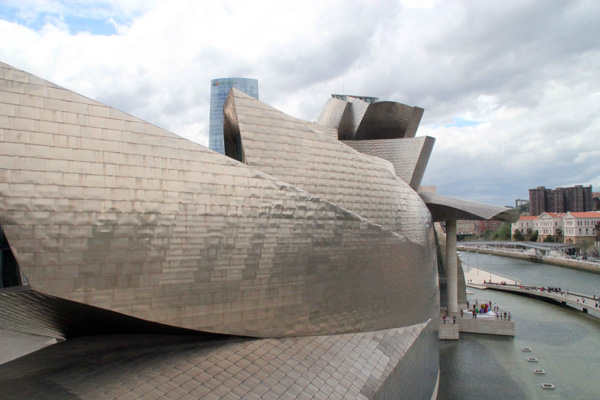
Bilbao's Guggenheim Museum, the city's stellar attraction on the Nervión River, can be seen from afar in all directions.
It is two days earlier and we are approaching Bilbao from Santander, lucky to have dodged the rain that hovered over the region during the past week. Once a rusty industrial town, Bilbao is now the jewel of the Basque country, completely reinventing itself after the building of its fabulous Guggenheim Museum. Even from afar, it's a stunner. Frank Gehry's shimmering titanium sails billow in unexpected directions above the Nervión River that links the city to the Bay of Biscay, inviting a long visit. "We will be spending several hours at the museum tomorrow," Jesús reassures those of us chomping at the bit to explore. In centuries past Bilbao's industries developed around its undulating river. Today, this once polluted waterway is sparkling clean, traversed by new bridges, including an arched suspension footbridge, its shipyards and steel mills removed or repurposed. An elegant subway system designed by Sir Norman Foster has relieved traffic and a new airport by renowned Spanish architect Santiago Calatrava has elevated Bilbao's status to a major destination. Traffic circles have been transformed into contemporary, landscaped plazas complete with sculptural lampposts. Near the river, new corporate buildings rise, harmonizing with the 19th century facades of older neighborhoods. We make our way to the upscale Melia Bilbao hotel near Do?a Casilda Park, an elegant hostelry built around a central atrium. A short walk before dinner is in order. The sun is sinking rapidly and rain clouds are breaking up, revealing a sky streaked in orange and pink, a dramatic backdrop for Cesar Pelli's Iberdola, a sleek, new 40-story office building. The aroma of pintxos (Basque finger foods) wafts in our direction. "Let's save them for another night," says my husband as we head for a bite at an indoor mall across the hotel.

A modernist column adorns the interior of Azkuna Zentroa, Philippe Starck's
innovative transformation of a wine warehouse into public leisure space.
It's a quiet Sunday morning with scattered clouds hovering overhead. Our bus takes off on a city tour, starting at Azkuna Zentroa, Bilbao's new mecca for culture and leisure. Artful columns hold up this unusual modernist complex. First built in 1909 as a wine warehouse, it was recently transformed by French architect Philippe Starck into a multi-purpose space for public recreation. Here one can find a multiplex cinema, fitness center, library, auditorium, restaurant and shops. "Look above," says Kathy, pointing to a glass-bottomed swimming pool, its patrons swooshing over our heads like human fish. "It cost 71 million euros to renovate this place," comments Sergio. "This site was even once considered a possible location for the Guggenheim."
At a windswept lookout on the Nervión, Sergio points to a long peninsula. "Bilbao is attracting top architects from all over the world," he says. "Zaha Hadid, a Pritzker Prize laureate, has designed a master plan, the Zorrozaurre, for this narrow strip once filled with shipyards." When completed, the strip will become an island with new residential and recreational space linked by several bridges to the city. "We are calling it the Manhattan of Bilbao," he announces with an impish smile. "In 1983 we had a major flood in the city and water covered the first floors of many buildings. This island will reduce the risk of floods in the future." Sergio motions to Bilbao's Maritime Museum designed by Juan Francisco Paz and opened in 2003. I notice a huge red crane rising in front of the building. "That's La Carola," Sergio divulges, "the last crane from the era of shipbuilding." According to local lore, there was a very beautiful woman in those days named Carola who used to take a boat to work every day. Every time she appeared, shipyard workers stopped dead in their tracks to admire her. The crane has become one of the symbols of Bilbao.
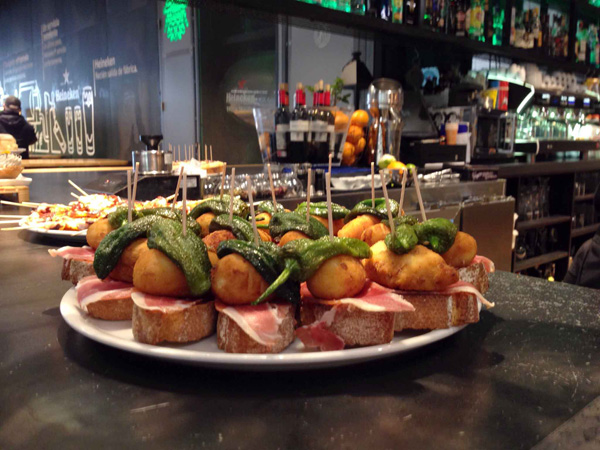
Pintxos are the ubiquitous finger foods of the Basque region. At La Ribera Market, guindilla peppers, tiny potatoes and thinly sliced ham are moistened with olive oil.
But not all of Bilbao is made up of new architecture. Casco Viejo, the city's oldest section, is crisscrossed by seven pedestrian streets packed with centuries-old buildings. In front of the City Hall, the red and white city flag hangs proudly. The bus deposits us at La Ribera Market, closed for shopping today, but open for a peek. "With 10,000 square meters, La Ribera is the largest indoor market in Europe," Sergio boasts. "In fact, it's listed in the Guinness Book of Records as the world's most complete municipal market, featuring more than 60 vendors." I can easily imagine endless stalls overflowing with Atlantic fish and mountains of produce. A solitary pintxo bar is in operation, its delectable little morsels inviting photos ops if not tastes. I get a whiff of fragrant guindilla peppers stacked atop tiny potatoes and paper-thin slices of ham. I gaze at a platter of spinach and egg omelet tortillas, at another featuring the underbelly of bread rubbed with fresh-cut tomatoes, and still another with tiny, crispy-fried calamares. "Yum," says my husband. "Too bad it's not lunchtime!"
"The old town dates back more than 700 years," notes Sergio as we stroll through a central street. "Here in Casco Viejo you can find many culinary clubs called txokos (chocos) where the men do all the cooking." We stop by a discrete sign pointing to Indartzu, a premier establishment. "Txokos are definitely a man's terroir, although a few have been admitting women of late," Sergio concedes. "They first appeared in the late 19th century in San Sebastián, becoming popular in Bilbao during the Franco dictatorship." Each txoko usually features a large kitchen, a wine cellar and long wooden tables where men can speak Euskera, eat their favorite pintxos, drink the best Rioja wines and beers, often in little glasses called chiquitos, and then break into song. As one might expect, the txokos are also the hangouts of the National Basque Party (ETA), a violent separatist movement until recent times. Today's party focuses more on economic issues and Basque Provinces enjoy limited control over the proceeds of their industries, investing in infrastructure and education.
We pause in front of Gorostiaga, a hat shop Victor Street specializing in tailor-made txapéla (berets), black for men and red for women. First opened in 1854, it is currently managed by Emilio Pila, a fourth-generation family member and expert on all kinds of hats. "I am not a hat wearer," I tell Johannes, an elegant gentleman and the elder statesman of our group who definitely wants to have a beret made to order for his annual sojourn in the Austrian Alps. "Perhaps Sergio would be willing to take me to the shop later," he whispers.
Several streets lead to Plaza Nueva, a large neoclassic square built in 1821 where the Basque Language Academy is located. "Today there are about 600,000 active speakers of Euskera, plus an equal amount who are passive speakers. Basque is now a co-official language," Sergio explains. The space is packed with locals who shop at its weekly flea market specializing in antiques, coins, rare books, stamps and even birds. We make our way through the crowd, passing by an area where young and old have congregated to trade soccer cards. They are immersed in intense sotto voce negotiations, complete with hand gestures. "Oh, how I remember the days of baseball cards!" I tell my husband. The plaza is lined with pintxo bars doing a brisk business. Sergio pauses in front of Bar Agroitia where barnacles, also called elephant legs, are the specialty of the house. "You can often find barnacles when the tide is low," he says. "But it's hard to find good ones. This chunk here sells for about 20 euros."

"Puppy," a towering topiary sculpture by Jeff Koons, welcomes visitors to the Guggenheim.
Not far from the Guggenheim, I sneak a sideways glance at a glass-enclosed subway entrance resembling a cocoon. "We call them 'Fosteritos,' after Norman Foster," Sergio chuckles. Straight ahead rises Jeff Koons's "Puppy," a 43-foot-high topiary sculpture covered with peonies. Puppy took Bilbao by storm from the git-go. When its stint was up, people happily contributed toward its purchase. We enter the museum from a sloping limestone plaza and I am left speechless. Gehry's high tech masterpiece exceeds everything I had imagined. Is it a giant ship with sails unfurling? Is it a whale coursing through waves? Sergio reveals how it all came into fruition: "Bilbao needed to do something to give the city a boost and the Guggenheim Foundation wanted to come here, even if it was risky venture. A consortium was created that was half private and half government. There was a competition for the design of the museum and Gehry won."
"Gehry drew inspiration from the Roman atrium," Sergio explains as we pause in the soaring 55-meter- central court. "He wanted to inject lots of natural light and he wanted the building to breathe. This is the signature design feature of many of his buildings." I notice that all the outer irregular forms connect to the atrium, with the biggest gallery facing north. The galleries are reached by glass elevators or long walkways. The exterior is a composite of glittering titanium tiles, glass and limestone, the latter originating from a quarry in Granada that had the perfect shade of amber to tie in with buildings in the city. Amazingly, the construction was completed in just over three years and the investment totally repaid in three more. "Its impact on the community has become a model for urban renewal," Sergio boasts. "It's called The Guggenheim Effect!" Indeed, more than a million tourists come to the museum each year and Bilbao is now a regular stop on most itineraries in Spain.
The Guggenheim is best utilized as a venue for changing exhibitions since its permanent collection is small. This works for the museum, enabling it to attract art lovers from all over the world. Among its permanent holdings are Warhol canvases and Richard Serra's "Matter of Time," a series of torqued steel ellipses that curl around "Snake," an existing sculpture. As you wind through its labyrinth, walls close in or move away, a unique experience. Part of the permanent collection is "Maman," a giant outdoor sculpture of a spider by Louise Bourgeois, an ode to her mother who was a weaver. We wander through a temporary exhibition, "Windows on the City: The School of Paris," featuring selected canvases by Picasso, Braque, Chagall and other artists. "It's time for a change of pace," says my husband as we exit the building. Conveniently, just beyond Puppy a gelateria beckons with an array of flavors and outdoor seating.
Later that evening all of us return to the museum's "Bistro" for a private dinner. A world class museum deserves a world class chef, and the Guggenheim does not disappoint. Josean Martinez Alija trained at El Bulli, Adrià Ferran's temple of molecular gastronomy, and Mugaritz. But he abandoned the esoteric repertoire of those establishments and created his own signature dishes based on quality ingredients, without the theatrics. From our crab terrine and roasted anchovies to a choice of hake Pil Pil-style or roast lamb accompanied with a vegetable and hazelnut puree, it is a memorable meal, augmented by very drinkable Rueda and Rioja wines. The dessert is classic Basque: torrija, a delicious bread pudding. I ask about Nerua, the museum's high-end second restaurant. "As you would expect," says Jesús, "it has a Michelin Star and a seasonal tasting menu that can last for hours!"
"Who exactly are the Basques?" asks Sergio the next morning as we head out to explore the countryside. "Two things we know for sure. Their language is not Indo-European and their DNA is the oldest in Europe, probably Neanderthal, with many Basques having RH negative blood type." The Basque people are shrouded in myth and mystery. They were fierce mountaineers whose geographic isolation enabled them to withstand invasion. They resisted the Romans, Visigoths, Arabs and Carolingians, always managing to retain their culture and language. Seafarers of great repute, they became the world's most intrepid whalers, challenging the Vikings. There is even evidence that they colonized Newfoundland well before the latter arrived. And since Basque men were always heading out to sea, a high risk occupation, a matrilineal culture was instituted, with women inheriting property and managing assets.

On the rugged Cantabrian coast, the tiny hermitage of San Juan de Gaztelugatxe is reached by a bridge and 241 steps. Over the centuries, it has served as a convent, chapel, military outpost and even a prison for witches.
"The Basques did not become Christian until about the 9th century," Sergio continues as we wind through emerald coastal hills. I am amazed to learn that it was not until the 11th or 12th century that their first writing appeared, and only when they adopted Latin characters. But even as they integrated into Catholic Spain, the Basques insisted on special privileges (fueros) that continue to this very day with their ability to maintain some control over their economic destiny. During the Spanish Civil War they sided with the Republicans against Franco. "For this they paid a dear price," Sergio explains. "Franco decided to make an example of the Basques and directed Hitler to carpet bomb Gernica (Guernica), a town that embodies their very soul. We will be heading to Gernika in a little while, where you will see a tile reproduction of Picasso's most famous painting."
We wind through coastal hills, past typical Basque farmhouses (caserios) and endless rolling farmlands. Nestled nearby is Bakio, a small agricultural town bordering the sea. Its unique microclimate attracts vintners who cultivate txakoli grapes for the production of light white wines. Suddenly the white-capped Atlantic emerges ahead, its waves crashing against massive boulders eroded by time. "We are going to make a quick stop at San Juan de Gaztelugatxe," Sergio announces. I can see it ahead: a little rock island accessed by a man-made stone bridge linked to a narrow path with hundreds of zigzagging steps ascending to a tiny hermitage. Dedicated to John the Baptist, the building once held a convent and then served as a prison for Basque witches during the Spanish Inquisition. A century later, it became a defensive outpost for the lords of Biscay and was even sacked by Sir Francis Drake! Adding to the mystique of the place, Sergio points to a plaque erected to honor those who perished here: "The Cantabrian coast is a dangerous and unpredictable place," he warns us.
Tracing the rugged coastline, once the epicenter of a thriving whaling industry, we approach Bermeo, an important fishing port with canneries for tuna and anchovies. When whaling became politically incorrect and the industry collapsed, the locals turned to fishing, soon rivaling Bilbao in their output. Today, an influx of immigrants from Senegal are the primary fishermen. "For the most part the Africans have been well integrated into the community," says Sergio. "Next to Bermeo is Mundaka," he continues, -"a spectacular place to surf. Every October surfers from all over the world come here to compete. Extremely powerful left-breaking waves roll in from the Bay of Biscay and explode against the rocks. You have to see it to believe it!"

Gernika's beloved tree, the Gernikako Arbola, grows inside a protective pavilion next to its petrified ancestor.
We continue to Gernika-Lumo, the site of the much-beloved Gernika Tree, or Gernikako Arbola. Underneath its branches, in a ritual dating back to the Middle Ages, its leaders swear to respect the rules and privileges of the Basque people. "Our tree, a common oak, is located just behind this Biscayan Assembly House, a place where our current leaders still gather to decide the fate of our region," says Sergio as we enter the building. Here, 53 deputies meet regularly to administrate taxes gathered in the region. Overhead, paintings of lords from different centuries appear to be sanctioning the proceedings. We step outside for a moment to view a petrified oak tree inside a closely-guarded circular pavilion. Next to it grows a 15-year-old tree, its fourth-generation descendant. Sergio pauses in front of a map displaying the Basque territories. "Out of nearly three million Basques, only 200,000 live in France, the rest are here in Spain," he explains as we continue to a room filled with exquisite stained glass, including an enormous ceiling depicting the tree and the history of the assembly house.
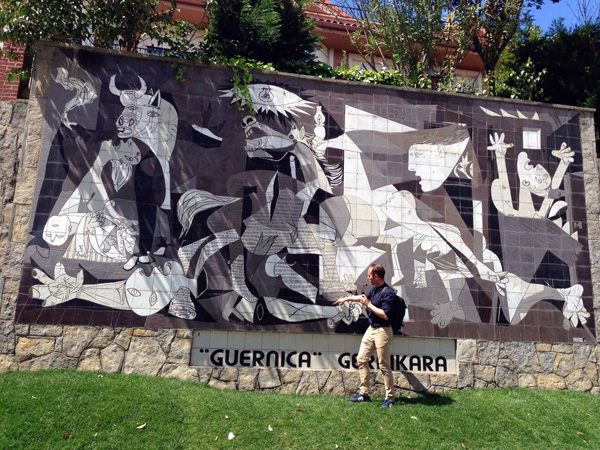
Sergio relates the story behind Picasso's "Guernica," a life-size reproduction of the famous painting.
A wall on Pedro de Elejalde Street displays a full-size reproduction of Picasso's Guernica, almost unanimously considered his finest work. Picasso had originally been commissioned by the Republicans opposed to Franco to produce a painting for the 1938 World's Fair in Paris. "But he was outraged by the attack that leveled the town. Instead, in a period of just two months, he painted a huge canvas depicting all the horror, so that the world would never forget the tragedy of war," Sergio clarifies, his voice intensifying.
Apparently, Hitler heard about the painting's fame and tried to acquire it so he could destroy it. Fortunately, Guernica toured all over Europe and was later taken to the Museum of Modern Art in New York where it hung for 23 years. Today it resides in the Reina Sofia Museum in Madrid. The Guggenheim has designated a special spot for it, believing that the painting should be displayed in Bilbao in a contemporary museum. "But so far, Guernica has not left Madrid," Sergio sighs.
The town's famous Monday market beckons. Here some 350 farmers from the surrounding region display exceptional produce, fresh flowers, artisanal breads, cheeses, and other products. I stop in front a stall with arrays of Gernika peppers and heirloom tomatoes, then by another with a mountain of eggs, and yet another with jars of Euskal Basseri preserves. A jovial meat vendor hawks streaky bacon and aromatic chorizo sausages. Across him a rotund lady fills small bags for customers, dipping into huge sacks of dry beans and chickpeas. The market whets our appetites, but we are holding off. A winetasting with pintxos awaits us at Bodega Berroja.
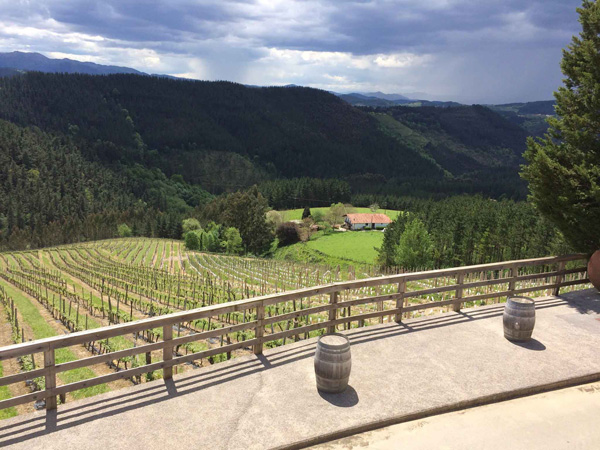
Bodega Berroja's rolling vineyards thrive on mountainous terrain, an ideal microclimate for the cultivation of txakoli grapes.
The bus turns up a narrow road, snaking through a dense pine forest. "This countryside is just amazing," exclaims Kathy, pointing her camera at a panorama of fields neatly planted with vines and subdivided into fenced areas. "The fences protect against wild boars," says Sergio. "This is the region where txakoli grapes thrive. They yield delightful white wines, some of them sparkling." Edna, a stunning young woman, welcomes us to the winery. "Originally txakoli wines were produced just for local consumption in homes," she notes. "But a small group of vintners persisted and eventually txakoli began to be distributed throughout Spain and exported abroad." She introduces us to José Ignacio, a Chilean winemaker who masterminds the operation at Berroja. "We have 16 hectares of land and a staff of 45 who harvest grapes by hand," he says, leading us down to the inner workings of the winery. José shows us a large tank where the grapes are pressed and then points to several others where the wine ferments. "Berroja produces about 80,000 bottles a year," he adds with pride. Upstairs, we gather around long tables in a multi-windowed room overlooking the vineyards. Three wine glasses and a plate of four pintxos have been set at each place. The straw yellow Berroja is refreshing, the greenish Augirrebeko has subtle hints of lemon, citrus and pineapple, but the 20 % Riesling Berroja is my personal favorite, particularly its long finish. It has been a memorable day. As we approach Bilbao, Sergio bids us a heartfelt farewell. "You must return to explore more of the Basque region," he insists. "Promise!"
"Who would like to join me for dinner this evening?" asks Jesús, who has a favorite place in mind only minutes from the hotel. La Casilda is a sleek, modern restaurant with a lively bar scene and a plethora of pintxos for every taste. Even though it's only eight o'clock, the bar is already packed with well-dressed locals. We take a quiet table in the rear. "I especially love their oxtail lasagna," recommends Jesús, pointing toward an aromatic dish just coming out of the kitchen. Seven of us order up a feast: stuffed peppers topped with bechamel sauce, bowls of steamed mussels, the lasagna, tiny meatballs, salads and crusty bread. Our Finca del Marquesado Rioja is a lovely complement to the feast.
The Basque region also includes Pamplona, capital of the Navarre Province. We make an early start toward the Pyrenees foothills to maximize our time in this lively city, known as Iru?a in Euskera. Here, broad avenues are lined with stately municipal buildings in a variety of styles, but of greater interest is its quaint medieval quarter. Pamplona's very name conjures up its annual July Festival of San Fermin and the Running of the Bulls, or Encierro. The city was first put the tourist map by Ernest Hemingway, who popularized it and dramatized it in his first novel, "The Sun Also Rises." Hemingway came here a total of nine times, for he had become totally obsessed with the Encierro. His celebratory book transformed a provincial festival into a global event.
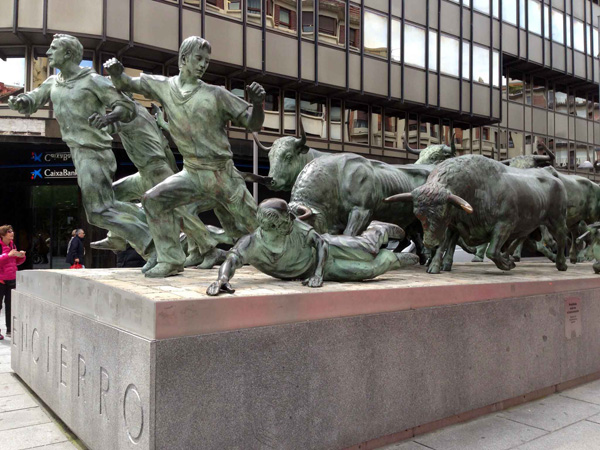
A huge bronze sculpture of Pamplona's "Encierro" captures a dramatic moment in the event.
On Roncevalles Street, a monumental bronze sculpture of the Encierro by Rafael Huerta depicts a dramatic moment in the running: Eleven young boys (mozos) race ahead of six bulls followed by three steers. Some have fallen down, hoping that they will not be trampled or gored. I look at their faces and can sense their anguish. They are so courageous, the bulls so powerful.
Jesús leads us past Plaza del Castillo, a massive square surrounded by arcaded buildings, down to the old Town Hall, the spot where the festival kicks off each year on July 6. "Two rockets always signal that the bulls have been released from their pen," he says. The runners, steers and bulls come up a sloping street on the right of Town Hall. They turn to the left and then right again on Calle de la Estafeta, finally taking a short diagonal into the bull ring. I have seen TV coverage of the spectacle: Streets are cordoned off and hundreds of runners dressed in white, red kerchiefs around their necks, run ahead of the bulls. Many are knocked down by the avalanche of runners, others are bloodied by the charging bulls, but amazingly, only 15 people have been killed since 1924. The run lasts about three minutes and is repeated with fresh animals each morning for eight more days. "Pamplona has about 200,000 residents," notes Jesús, "but during the Encierro, the place swells to nearly a million, it is that popular!"
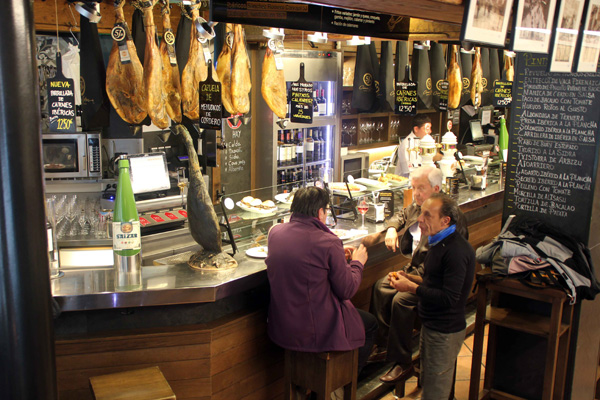
Pricey Iberico hams are on display at Bodegon Sarria, a popular pintxo bar on Calle de la Estafeta.
We wander down to the bull ring. To the left of the entrance, a bearded Hemingway in bronze is being photographed by a Swedish tour group. On Calle de la Estafeta, Bodegon Sarria is a handsome restaurant that has been highly recommended for its superb Iberico ham pintxos. The ham is pricey, produced from specially bred, free-range pigs who roam oak forests and consume an exclusive diet of acorns. We wash down our pintxos with a refreshing craft beer on tap. "For sure this was the tastiest ham ever," says my husband as we head down a few doors to Beatriz, a pastry shop extraordinaire. Famed for its chocolate garrotikos, flaky chocolate confections with a molten center, the place is jam-packed with trays of tartlets, muffins and wafers, not to mention customers. We fill a small bag with their dark chocolate bars studded with almonds. On Plaza del Castillo, the Belle Epoque Café Iru?a, once a favorite haunt of Hemingway, is a must see. Supposedly, it has barely changed in 91 years. I glance at a huge polished mirror mounted over a long bar. The scuffed black and white floor looks original, as do Moorish columns rising up to an ornate ceiling. Tables of locals are noisily chattering over café con leche and tourists are quaffing sangria with their pintxos. There is not a single empty table. Next to the bar in the former smoking room, I catch a glimpse of another bronze Hemingway.
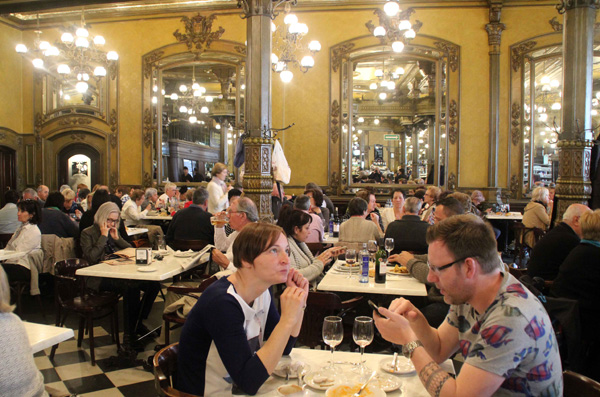
Café Iruna on Plaza del Castillo, once a favorite hangout of Ernest Hemingway, has barely changed during 91 years of operation.
Leaving Pamplona, I realize that we've had but a taste of Euskal Herria.
So much more of the Basque region still remains to be seen and savored:
San Sebastián, Hondarribia, Vittoria-Gasteiz, not to mention the
breathtaking Guipuszcoa Coast. "We're coming back," I tell my
husband who nods his head vigorously.
